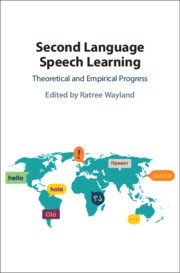Book contents
- Second Language Speech Learning
- Second Language Speech Learning
- Copyright page
- Dedication
- Contents
- Figures
- Tables
- Contributors
- Preface
- Acknowledgments
- Part I Theoretical Progress
- Part II Segmental Acquisition
- Part III Acquiring Suprasegmental Features
- Chapter 9 Relating Production and Perception of L2 Tone
- Chapter 10 Production of Mandarin Tones by L1-Spanish Early Learners in a Classroom Setting
- Chapter 11 Production of English Lexical Stress by Arabic Speakers
- Chapter 12 Variability in Speaking Rate of Native and Nonnative Speech
- Part IV Accentedness and Acoustic Features
- Part V Cognitive and Psychological Variables
- Index
- References
Chapter 9 - Relating Production and Perception of L2 Tone
from Part III - Acquiring Suprasegmental Features
Published online by Cambridge University Press: 21 January 2021
- Second Language Speech Learning
- Second Language Speech Learning
- Copyright page
- Dedication
- Contents
- Figures
- Tables
- Contributors
- Preface
- Acknowledgments
- Part I Theoretical Progress
- Part II Segmental Acquisition
- Part III Acquiring Suprasegmental Features
- Chapter 9 Relating Production and Perception of L2 Tone
- Chapter 10 Production of Mandarin Tones by L1-Spanish Early Learners in a Classroom Setting
- Chapter 11 Production of English Lexical Stress by Arabic Speakers
- Chapter 12 Variability in Speaking Rate of Native and Nonnative Speech
- Part IV Accentedness and Acoustic Features
- Part V Cognitive and Psychological Variables
- Index
- References
Summary
This chapter considers the relation between production and perception of L2 tone in speakers of Kiên Giang Khmer who are fluent to varying degrees in Southern Vietnamese. In addition to directly comparing L2 to L1 performance in tonal production and perception, we explore how perception might be related to the internal organization of a speaker’s own production system by comparing distances between f0 curves to accuracy in a speeded AX discrimination task. Relative to native speakers, we found considerable individual variation among speakers of Kiên Giang Khmer with L2 knowledge of Vietnamese in the degree to which they approximated Vietnamese tonal targets. Production accuracy was most strongly related to age, while discrimination performance correlated best with education. In addition, we observed a weak correlation between the acoustic distance of a Khmer speaker’s production of tone T to the native Vietnamese production of T, and the ability to discriminate tone T from other tones. However, speakers who acoustically separated two tones in their own productions were also more accurate at discriminating those tones in perception, regardless of how well those productions approximated native speaker targets.
- Type
- Chapter
- Information
- Second Language Speech LearningTheoretical and Empirical Progress, pp. 249 - 272Publisher: Cambridge University PressPrint publication year: 2021
References
- 1
- Cited by



